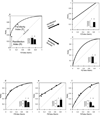Towards a functional organization of episodic memory in the medial temporal lobe
- PMID: 21810443
- PMCID: PMC3227798
- DOI: 10.1016/j.neubiorev.2011.07.006
Towards a functional organization of episodic memory in the medial temporal lobe
Abstract
Here we describe a model of medial temporal lobe organization in which parallel "what" and "where" processing streams converge within the hippocampus to represent events in the spatio-temporal context in which they occurred; this circuitry also mediates the retrieval of context from event cues and vice versa, which are prototypes of episodic recall. Evidence from studies in animals are reviewed in support of this model, including experiments that distinguish characteristics of episodic recollection from familiarity, neuropsychological and recording studies that have identified a key role for the hippocampus in recollection and in associating events with the context in which they occurred, and distinct roles for parahippocampal region areas in separate "what" and "where" information processing that contributes to recollective and episodic memory.
Copyright © 2011 Elsevier Ltd. All rights reserved.
Figures





References
-
- Aggleton JP, Nicol RM, Huston AE, Fairbairn AF. The performance of amnesic subjects on tests of experimental amnesia in animals, delayed matching-to-sample and concurrent learning. Neuropsychologia. 1988;26:265–272. - PubMed
-
- Bowles B, Crupi C, Pigott S, Parrent A, Wiebe S, Janzen L, Köhler S. Double dissociation of selective recollection and familiarity impairments following two different surgical treatments for temporal-lobe epilepsy. Neuropsychologia. 2010;48:2640–2647. - PubMed
Publication types
MeSH terms
Grants and funding
LinkOut - more resources
Full Text Sources
Other Literature Sources

